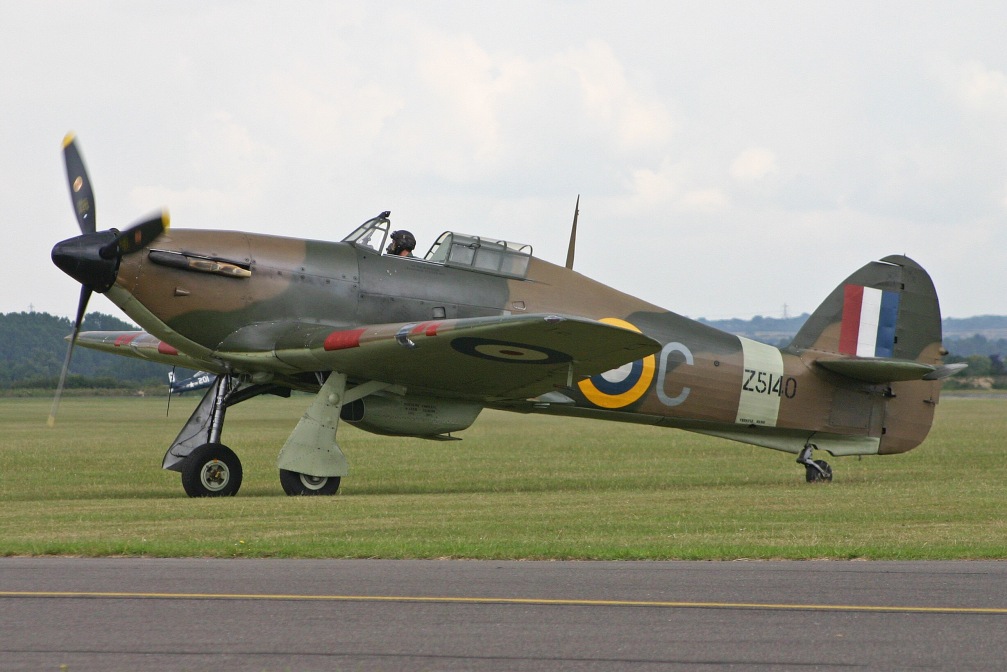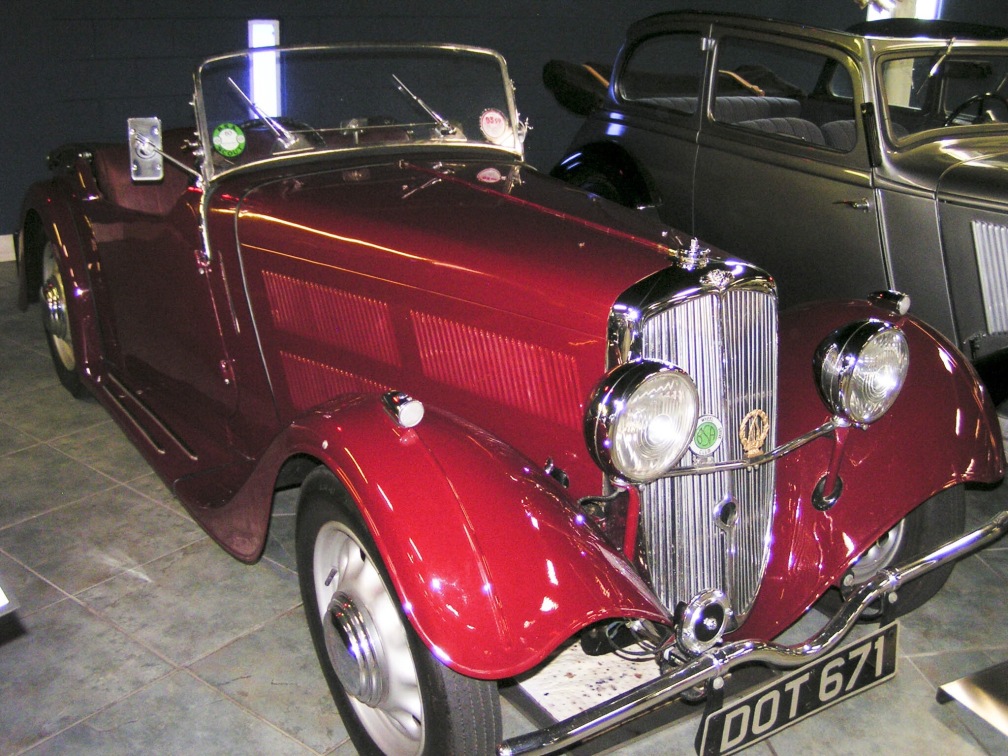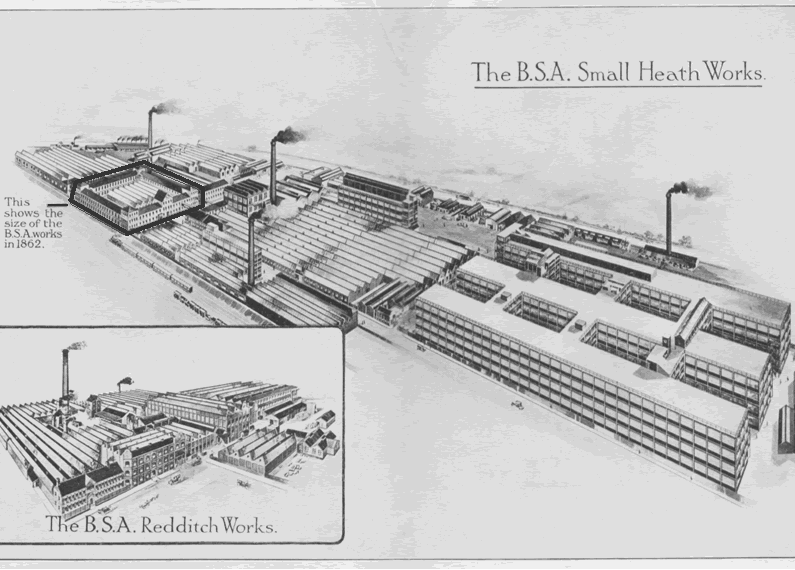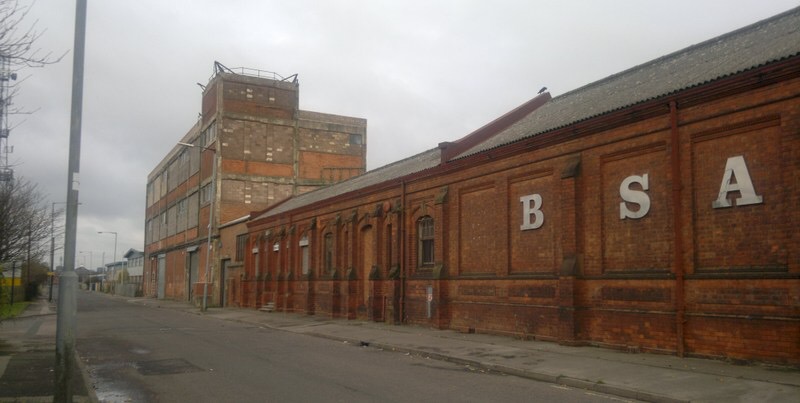I love owning a BSA bicycle. I know it isn’t a proper, Birmingham-built BSA, but it still bears the piled arms logo of one of the greatest industrial concerns of the English Midlands. Birmingham isn’t home for me but it’s not too far, just a 40 minute train away, and I spent a year working near Edgbaston. A lot of Birmingham, and a lot of the Midlands, has a similar feel to it of a place that was once the beating heart of a mighty industrial empire. Much of the industry has gone, but they’ve left behind a kind of ectoplasm.
Why do I feel romantic about Birmingham Small Arms? Well, it all comes back to my greatest love: cars. Just before the First World War BSA merged with Daimler – not Daimler as in Mercedes, but the British firm that had licensed the name and built what many regarded as the best cars money could buy. Royalty drove Daimlers, Rolls Royces were regarded as being a bit ‘common’ by comparison. So after the great demand on BSA of supplying the war subsided, BSA moved briefly into car manufacture under their own name, and several decades later my old teacher at school drove one – A 1937 BSA Scout, that looked exactly like a sportscar should:
So that was my introduction to what BSA stood for, but I never knew just how enormous BSA was in its pomp. It employed nearly 30,000 people in 1945, and made a seriously large amount of guns supplying all manner of conflicts from the time when British red coats used their Martini-Henris to suppress whichever poor bunch of natives armed with little more than pointed sticks they happened to be colonising that year. When I put it like that it does somewhat tarnish any glamour the name of BSA might have, but think also that they made upwards of half a million of the .303 Browning machine guns fitted to the Hurricanes and Spitfires that won the Battle of Britain.

Yep, half a million. And that was just one gun type. They made Lee-Enfield rifles, and Bren guns, and magazines, and shell casings, and bullets, and so on and so on, in vast quantities. Perhaps the most incredible fact I’ve come across was that a single bombing raid on the BSA factory in Small Heath knocked out more machines than the bombing of Coventry – by no means a lightweight industrial city itself. That’s A LOT of machinery. This picture shows the scale of the Small Heath factory:
The story of BSA seems to start so simply, then get progressively more complicated after the end of the Second World War. It started off as a company formed so that a band of Birmingham gunsmiths could buy the machinery necessary to compete with Royal Enfield for Government arms contracts. When demand for rifles fell after various wars ended, the company found itself underemployed and looked for other things to make, starting with bicycles. It gave up making whole bicycles, concentrating instead on bicycle components, then decided to make whole bicycles again shortly before the turn of the 20th century. When the Government signed a deal to purchase BSA bicycles for the army, BSA standard fittings became the standard fitting for most bicycles, and some standard fittings today are still based on BSA’s.

As stated above, they purchased the Daimler Motor Company, then between the wars played around with making BSA-branded front wheel drive cars and acquired Lanchester motors in 1930. They also started making motorbikes, and this is perhaps their most famous product (especially the Gold Star shown below). After the Second World War they were the largest motorbike manufacturers in the world, following their purchase of Triumph in 1951. All does not seem to have been well, however, and the company started selling bits off at the end of the 1950s. BSA cycles started to make a loss and was bought by Raleigh in 1957, and Daimler (and the already defunct Lanchester) was bought by Jaguar in 1960.

The motorcycle business continued, but from here the story begins to sound depressingly familiar to anyone versed in the decline of British manufacturing in the 1960s and 1970s. Japanese, and also German, motorbikes weren’t necessarily better than British ones to begin with, but the product was more consistent, more reliable, increasingly more modern and also cheaper. Worse still, while British Leyland had a large and buoyant domestic car market to fall back on, somewhere between 60-80% of BSA’s bikes were exported, into markets Japanese firms plundered with great success. 1971 seems to have been a particularly bad year, with BSA effectively maxing out their credit with the banks. There was the inevitable Government intervention, followed by the inevitable trade union troubles when the newly-amalgamated company looked to cut costs, though this mainly centred around the rather militant Triumph factory in Meriden. By the end of 1973 it was all over for BSA, only two decades after their peak. It’s enough to make you weep.
What’s left now then? The BSA brand still exists in a number of former subsidiaries in various industries, but is a very minor player. BSA Regal makes machine tools and BSA motorbike spares. Tube Investments India has the rights to make bicycles under the BSA and Hercules brands in India. The BSA car brand is either owned by some Chinese company or may reside with TATA, the Indian owners of Jaguar Land Rover. Though Spanish-owned, BSA Guns does continue to manufacture air rifles in Birmingham, but they’re pop guns compared with the firearms BSA originally sought to make.
It’s all a far cry from the mighty company that at one time made the best cars, the best motorbikes, the best bicycles and huge amounts of munitions that helped win two world wars.



The full story of the decline can be found here.
Click to access the-rise-fall-of-the-british-motorcycle-industry.pdf
LikeLike
Cool, thanks very much!
LikeLike